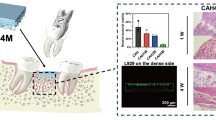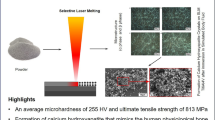Abstract
Glass polyalkenoate cements (GPCs) have previously been considered for orthopedic applications. A Zn–GPC (BT 101) was compared to commercial GPCs (Fuji IX and Ketac Molar) which have a setting chemistry analogous to BT 101. Handling properties (working, T w and setting, T s times) for BT 101 were shorter than the commercial GPCs. BT 101 also had a higher setting exotherm (S x —34 °C) than the commercial GPCs (29 °C). The maximum strengths for BT 101, Fuji IX, and Ketac Molar were 75, 238, and 216 MPa (compressive, σ c), and 34, 54, and 62 MPa (biaxial flexural strengths, σ f), respectively. The strengths of BT 101 are more suitable for spinal applications than commercial GPCs.





Similar content being viewed by others
References
Tyas MJ, Burrow MF. Adhesive restorative materials: a review. Aust Dent J. 2004;49(3):112–21.
Nicholson JW,Wilson AD. Acid–Base cements — their biomedical and industrial applications. Chemistry of Solid State Materials. Vol. 3. 1993: Cambridge.
Nicholson JW. Adhesive dental materials—a review. Int J Adhes Adhes. 1998;18(4):229–36.
Smith DC. Development of glass–ionomer cement systems. Biomaterials. 1998;19(6):467–78.
Cho S, Cheng AC. A review of glass ionomer restorations in the primary dentition. J Can Dent Assoc. 1999;65:491–5.
DeBruyne MAA, DeMoor RJG. The use of glass ionomer cements in both conventional and surgical endodontics. Int Endod J. 2004;37:91–104.
Akinmade AO, Nicholson JW. Glass ionomer cements as adhesives. J Mater Sci Mater Med. 1993;4(2):95–101.
Higgs WA, Lucksanasombool P, Higgs RJED, Swain MV. Comparison of the material properties of PMMA and glass ionomer based cements for use in orthopedic surgery. J Mater Sci Mater Med. 2001;12:453–60.
Zimehl R, Hannig M. Non metallic restorative materials based on glass ionomer cements — recent trends and developments. Colloids Surf A: Physicochem Eng Asp. 2000;163(1):55–62.
Reusche E, Pilz P, Oberascher G, Linder B, Egensperger R, Gloeckner K, Trinka E, Iglseder B. Subacute fatal aluminium encephalopathy after reconstructive otoneurosurgery: a case report. Human Pathol. 2001;32(10):1136–9.
Hatton PV, Hurrell-Gillingham K, Reaney IM, Miller CA, Crawford A. Devitrification of ionomer glass and its effect on the in vitro biocompatibility of glass ionomer cements. Biomaterials. 2003;24:3153–60.
Polizzi S, Pira E, Ferrara M, Bugiani M, Papaleo A, Albera R, Palmi S. Neurotoxic effects of aluminium among foundry workers and alzheimers disease. Neurotoxicology. 2002;23:761–74.
Weber A, May A, von Ilberg C. Bone replacement by ionomer cement in osteoplastic frontal sinus operations. Eur Arch Otorhinolaryngol. 1997;254(1):162–4.
Firling CE, Hill TA, Severson AR. Aluminium toxicity perturbs long bone calcification in the embryonic chick. Arch Toxicol. 1999;73:359–66.
DeMaeyer EAP, Verbeeck RMH, Vercruysse CWJ. Infrared spectrometric study of acid degradable glasses. J Dent Res. 2002;81(8):552–5.
Nicholson JW. Chemistry of glass ionomer cements. Biomaterials. 1998;19:485–94.
Yamaguchi M, Ma ZJ. Role of endogenous zinc in the enhancement of bone protein synthesis associated with bone growth of newborn rats. J Miner Metab. 2001;19:38–44.
Yamaguchi M, Ma ZJ. Stimulatory effect of zinc on Deoxyribonucleic acid synthesis in bone growth of newborn rats: enhancement with zinc and insulin like growth factor-I. Calcif Tissue Int. 2001;69:158–63.
Wren AW, Boyd D, Thornton R, Cooney JC, Towler. Antibacterial properties of a tri-sodium citrate modified glass polyalkenoate cement. J Biomed Mater Res B Appl Biomater. 2009;90-B(2):700–9.
Sawai J. Quantitative evaluation of antibacterial activities of metallic oxide powders (ZnO, MgO and CaO) by conductimetric assay. J Microbiol Methods. 2003;54:177–82.
Sawai J, Shinobu S, Igarashi H, Hashimoto A, Kokugan T, Shimizu M, Kojima K. Hydrogen peroxide as an antibacterial factor in zinc oxide powder slurry. J Biosci Bioeng. 1998;86(5):521–2.
Marie PJ. Strontium ranelate: new insights into its dual mode of action. Bone. 2007;40(5):S5–8.
Marie PJ. Strontium ranelate; a novel mode of action optimizing bone formation and resorption. Osteoporos Int. 2005;16:S7–10.
International Organization for Standardization 9917, Dental Water Based Cements (E), in Case Postale 56. 1991: Geneva, Switzerland. p. CH–11211.
Williams JA, Billington RW, Pearson GJ. The effect of the disc support system on biaxial tensile strength of a glass ionomer cement. Dent Mater. 2002;18:376–9.
Higgs WAJ, Lucksanasombool P, Higgs RJED, Swain MV. A simple method of determining the modulus of orthopaedic bone cement. J Biomed Mater Res (Appl Biomater). 2006;58:188–95.
Boyd D, Towler MR, Watts S, Hill RG, Wren AW, Clarkin OM. The role of Sr2+ on the structure and reactivity of SrO–CaO–ZnO–SiO2 ionomer glasses. J Mater Sci: Mater Med. 2008;19:953–7.
Stamboulis A, Law RV, Hill RG. Characterization of commercial ionomer glasses using magic angle nuclear magnetic resonance (MAS–NMR). Biomaterials. 2004;25(17):3907–13.
Van Duinen RNB, Kleverlaan CJ, de Gee AJ, Werner A, Feilzer AJ. Early and long-term wear of ‘Fast-set’ conventional glass–ionomer cements. Dent Mater. 2005;21(8):716–20.
Pascual B, Vazquez B, Gurrachaga M, Goni I, Ginebra MP, Gil FJ, Planell JA, Levenfeld B, Roman JS. New aspects of the effect of size and size distribution on the setting parameters and mechanical properties of acrylic bone cements. Biomaterials: Processing, Testing and Manufacturing Technology. 1996;17(5):):509–16.
Kaplan AE, Williams J, Billington RW, Braden M, Pearson GJ. Effects of variation in particle size on biaxial flexural strength of two conventional glass–ionomer cements. J Oral Rehabil. 2004;31:373–8.
Serra J, Gonzalez P, Liste S, Chiussi S, Leon B, Perez-amor M, Ylanen HO, Hupa M. Influence of the non-bridging oxygen groups on the bioactivity of silicate glasses. J Mater Sci: Mater Med. 2002;13:1221–5.
Wilson AD, Hill RG, Warrens CP, Lewis BG. The influence of Polyacid molecular weight on some properties of glass ionomer cements. J Dent Res. 1989;68(2):89–94.
Billington RW, Williams JA, Pearson GJ. Ion processes in glass ionomer cements. J Dent. 2006;34:544–55.
Bergmann G, Graichen F, Rohlmann A, Verdonschot N, van Lenthe GH. Frictional heating of total hip implants. Part 2: finite element study. J Biomech. 2001;34(4):429–35.
Deramond H, Wright NT, Belkoff SM. Temperature elevation caused by bone cement polymerization during vertebroplasty. Bone. 1999;25(2):17–21.
Nomoto R, McCabe JF. Effect of mixing methods on the compressive strength of glass ionomer cements. J Dent. 2001;29:205–10.
Azillah MA, Anstice HM, Pearson GJ. Long term flexural strength of three direct aesthetic restorative materials. J Dent. 1998;26(2):177–82.
Khouw-Liu VHW, Anstice HM, Pearson GJ. An in vitro investigation of a poly(vinyl phosphonic acid) based cement with four conventional glass ionomer cements. Part 1: flexural and fluoride release. J Dent. 1999;27:351–7.
Higgs WAJ, Lucksanasombool P, Higgs RJED, Swain MV. Evaluating acrylic and glass–ionomer cement strength using the biaxial flexure test. Biomaterials. 2001;22(12):1583–90.
Turner CH, Takano Y, Rho J, Tsui TY, Pharr GM. The elastic properties of trabecular and cortical bone tissues are similar: results from two microscopic measurement techniques. J Biomech. 1999;32:437–41.
Zioupos P, Currey JD, Hamer AJ. The role of collagen in the declining mechanical properties of aging human cortical bone. J Biomed Mater Res. 1998;45(2):108–16.
Boyd D, Towler MR, Wren AW, Clarkin OM. Comparison of an experimental bone cement with surgical simplex p, spineplex and cortoss. J Mater Sci Mater Med. 2008;19(4):1745–52.
Author information
Authors and Affiliations
Corresponding author
Rights and permissions
About this article
Cite this article
Wren, A.W., Coughlan, A., Laffir, F.R. et al. Comparison of a SiO2–CaO–ZnO–SrO glass polyalkenoate cement to commercial dental materials: glass structure and physical properties. J Mater Sci: Mater Med 24, 271–280 (2013). https://doi.org/10.1007/s10856-012-4813-1
Received:
Accepted:
Published:
Issue Date:
DOI: https://doi.org/10.1007/s10856-012-4813-1




